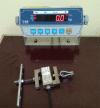Osseointegration of porous titanium and tantalum implants in ovariectomized rabbits: A biomechanical study
- PMID: 33959485
- PMCID: PMC8082506
- DOI: 10.5312/wjo.v12.i4.214
Osseointegration of porous titanium and tantalum implants in ovariectomized rabbits: A biomechanical study
Abstract
Background: Today, biological fixation of uncemented press-fit acetabular components plays an important role in total hip arthroplasty. Long-term stable fixation of these implants depends on the osseointegration of the acetabular cup bone tissue into the acetabular cup implant, and their ability to withstand functional loads.
Aim: To compare the strength of bone-implant osseointegration of four types of porous metal implants in normal and osteoporotic bone in rabbits.
Methods: The study was performed in 50 female California rabbits divided into non-ovariectomized (non-OVX) and ovariectomized groups (OVX) at 6 mo of age. Rabbits were sacrificed 8 wk after the implantation of four biomaterials [TTM, CONCELOC, Zimmer Biomet's Trabecular Metal (TANTALUM), and ATLANT] in a 5-mm diameter defect created in the left femur. A biomechanical evaluation of the femur was carried out by testing implant breakout force. The force was gradually increased until complete detachment of the implant from the bone occurred.
Results: The breakout force needed for implant detachment was significantly higher in the non-OVX group, compared with the OVX group for all implants (TANTALUM, 194.7 ± 6.1 N vs 181.3 ± 2.8 N; P = 0.005; CONCELOC, 190.8 ± 3.6 N vs 180.9 ± 6.6 N; P = 0.019; TTM, 186.3 ± 1.8 N vs 172.0 N ± 11.0 N; P = 0.043; and ATLANT, 104.9 ± 7.0 N vs 78.9 N ± 4.5 N; P = 0.001). In the OVX group, The breakout forces in TANTALUM, TTM, and CONCELOC did not differ significantly (P = 0.066). The breakout force for ATLANT in the OVX group was lower by a factor of 2.3 compared with TANTALUM and CONCELOC, and by 2.2 compared with TTM (P = 0.001). In the non-OVX group, the breakout force for ATLANT was significantly different from all other implants, with a reduction in fixation strength by a factor of 1.9 (P = 0.001).
Conclusion: TANTALUM, TTM, and CONCELOC had equal bone-implant osseointegration in healthy and in osteoporotic bone. ATLANT had significantly decreased osseointegration (P = 0.001) in healthy and in osteoporotic bone.
Keywords: Animals; Bone-implant interface; Femur; Osteoporosis; Tantalum; Titanium.
©The Author(s) 2021. Published by Baishideng Publishing Group Inc. All rights reserved.
Conflict of interest statement
Conflict-of-interest statement: Bondarenko S, Filipenko V, Karpinsky M, Karpinska O, Ivanov G, Maltseva V, and Badnaoui AA declare that they have no conflict of interest. Schwarzkopf R has potential competing interests; he is a paid consultant of Smith & Nephew, Memphis, TN, United States.
Figures





References
-
- Gruen TA, Poggie RA, Lewallen DG, Hanssen AD, Lewis RJ, O'Keefe TJ, Stulberg SD, Sutherland CJ. Radiographic evaluation of a monoblock acetabular component: a multicenter study with 2- to 5-year results. J Arthroplasty. 2005;20:369–378. - PubMed
-
- Karachalios T. Bone-implant interface in orthopedic surgery: basic science to clinical applications. London: Springer-Verlag, 2014: 13-26.
-
- Naziri Q, Issa K, Pivec R, Harwin SF, Delanois RE, Mont MA. Excellent results of primary THA using a highly porous titanium cup. Orthopedics. 2013;36:e390–e394. - PubMed
-
- Marin E, Fedrizzi L, Zagra L. Porous metallic structures for orthopaedic applications: a short review of materials and technologies. Eur Orthop Traumatol. 2010;1:103109.
LinkOut - more resources
Full Text Sources
Other Literature Sources

